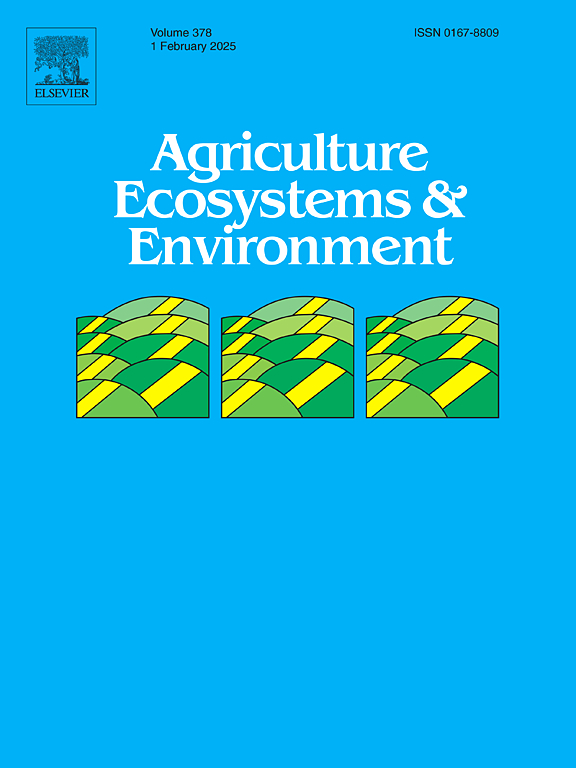耕作强度和经杀虫剂处理的种子对玉米-大豆轮作中表皮节肢动物群落和杂草种子捕食的影响
IF 6
1区 农林科学
Q1 AGRICULTURE, MULTIDISCIPLINARY
引用次数: 0
摘要
耕作方法和农药种子处理剂(PST)的使用都有可能影响表皮节肢动物群落及其提供的生态系统服务,但很少有研究同时考察这两个因素。一项为期三年(2017-2019 年)的田间研究在美国新罕布什尔州东南部的一个长期行作物耕作强度实验中进行,目的是评估耕作和农药种子处理对表皮节肢动物群落和杂草种子捕食的独立和交互影响。在整个研究过程中,玉米和大豆在三种耕作制度(全耕、条耕和免耕)下轮作种植,采用四次重复的随机完全区组设计,使用或不使用农药种子处理剂(含有系统性和接触性杀真菌剂及新烟碱类杀虫剂混合物的种子包衣剂)。在2018-2019年9月至10月期间,使用坑式陷阱对外延节肢动物群落进行了采样,并在2017-2019年每年的同一时期对杂草种子捕食情况进行了评估。研究期间共观察到 1669 个节肢动物个体,代表 47 个分类群。2018 年,表皮节肢动物群落仅因农药种子处理而不同。2019 年观察到了相反的反应,表皮节肢动物群落仅因耕作而不同。与全耕处理相比,2018 年条耕处理中黑翼角雉(Illiger)的活动密度更高。2017 年和 2019 年,无脊椎动物对散播后杂草种子的年捕食水平(去除种子总量的百分比)因耕作处理而异,但 2018 年没有变化,根据年份和处理的不同,捕食水平从低至 6.1%到高至 27.2%不等。这些数据提供的证据表明,农药种子处理和耕作制度都会影响栖息在一年生行作物农业生态系统中的表皮节肢动物群落,在生长季节相对较晚的时候,大部分农药残留可能已经消散,而该群落成员提供的杂草种子捕食服务会受到密集耕作的强烈负面影响。本文章由计算机程序翻译,如有差异,请以英文原文为准。
Effects of tillage intensity and pesticide treated seeds on epigeal arthropod communities and weed seed predation in a maize-soybean rotation
Tillage practices and the use of pesticide seed treatments (PST) both have the potential to influence epigeal arthropod communities and the ecosystem services they provide, yet few studies have examined both factors in conjunction. A three-year field study (2017–2019) was conducted to assess the independent and interactive effects of tillage and pesticide seed treatments on epigeal arthropod communities and weed seed predation in a long-term row crop tillage intensity experiment located in southeastern New Hampshire, USA. Throughout the study, maize and soybean were planted in rotation with and without pesticide seed treatments (seed coatings containing a mixture of systemic and contact fungicides and neonicotinoid insecticides) under three tillage systems (full-, strip-, and no-till) in a randomized complete block design with four replications. Epigeal arthropod communities were sampled with pitfall traps from September to October 2018–2019 and weed seed predation was assessed over the same period each year from 2017–2019. A total of 1669 individual arthropods, representing 47 taxonomic groups, were observed over the course of the study. In 2018, epigeal arthropod communities differed based only on pesticide seed treatment. The opposite response was observed in 2019, as epigeal arthropod communities differed based only on tillage. Activity densities of Pterostichus melanarius (Illiger) were higher in the strip-till compared to full-till treatment in 2018. Annual levels of post-dispersal weed seed predation by invertebrates (% total seeds removed) varied based on tillage treatment in 2017 and 2019, but not in 2018, and ranged from as low as 6.1 % to as much as 27.2 % depending on year and treatment. These data provide evidence that both pesticide seed treatments and tillage systems can influence the communities of epigeal arthropods that inhabit annual row crop agroecosystems relatively late in the growing season, when the majority of pesticide residues have likely dissipated, and that the weed seed predation services provided by members of this community can be strongly negatively impacted by intensive tillage.
求助全文
通过发布文献求助,成功后即可免费获取论文全文。
去求助
来源期刊

Agriculture, Ecosystems & Environment
环境科学-环境科学
CiteScore
11.70
自引率
9.10%
发文量
392
审稿时长
26 days
期刊介绍:
Agriculture, Ecosystems and Environment publishes scientific articles dealing with the interface between agroecosystems and the natural environment, specifically how agriculture influences the environment and how changes in that environment impact agroecosystems. Preference is given to papers from experimental and observational research at the field, system or landscape level, from studies that enhance our understanding of processes using data-based biophysical modelling, and papers that bridge scientific disciplines and integrate knowledge. All papers should be placed in an international or wide comparative context.
 求助内容:
求助内容: 应助结果提醒方式:
应助结果提醒方式:


